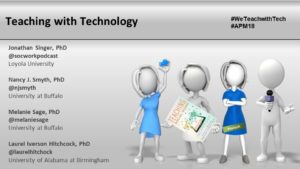Review of Teaching & Learning in Social Work for 2018
One of the reasons I like a good “end-of-the-year list” is the opportunity to reflect on what I did and did not miss out on over the past year. I’m always thrilled to discover I read one or maybe even two of the most notable books on the New York Times yearly list. Then, I start planning my reading wish list for the coming year, which usually involves magical thinking about reading every winner of the Nobel Prize for Literature or the all the Pulitzer Prize winners for Non-Fiction from the last ten years. Even if I don’t actually read all of these books, I believe in having some goals for my reading and other activities. For the Teaching and Learning in Social Work Blog, I had three goals for 2018:
1 .Write or publish 30 blog posts
2. Increase the number of blog subscribers from 100 to 200
3. Publish 10 guest educator blog posts
Here is how those goals worked out:
1. Wrote only 13 blog posts during the year, but published a total of 21 posts (70% completed)
2. Only added 40 more subscribers to the blog (40% completed)
3. Published 8 guest educators posts (80% completed)
While not all my goals were achieved, I was still able to collaborate with others to accomplish some solid writing for the blog including information about projects that I have been working on, and all my conference presentations for the year. Below is a list of this year’s posts, grouped around the topics of projects, guest educator posts, and conference presentations.
Projects: These posts describe new projects that I started or worked on during 2018:
Using an Interprofessional Perspective for NASW’s Technology Standard for Social Work Education
 On Saturday, November 10, 2018 at 7:30 am in Dolphin, Walt Disney World Resort, Asia 3, Lobby/Third Level, I will be presenting with Drs. Melanie Sage and Nancy J. Smyth about our crowd sourced work, Social Work Educators’ Perspectives on NASW’s Technology Standard for Education, Training, and Supervision. We will be distributing printed copies of our booklet and sharing how social work educators can bring an interprofessional perspective to teaching with technology.
On Saturday, November 10, 2018 at 7:30 am in Dolphin, Walt Disney World Resort, Asia 3, Lobby/Third Level, I will be presenting with Drs. Melanie Sage and Nancy J. Smyth about our crowd sourced work, Social Work Educators’ Perspectives on NASW’s Technology Standard for Education, Training, and Supervision. We will be distributing printed copies of our booklet and sharing how social work educators can bring an interprofessional perspective to teaching with technology.
In 2017, new Standards for Technology in Social Work Practice were issued by NASW (and written in conjunction with CSWA, CSWE, and ASWB) to address the intersections of social work practice and technology. One of the standards (standard 4) focuses on technology for social work education, training, and supervision, while the other standards focus on the use of technology in social work practice.
After the standards came out, social work educators told us they wanted more information about how to actually use the guidance from the standards in their classrooms and universities. We (Laurel Hitchcock, Melanie Sage, and Nancy Smyth) reached out to social work educators and supervisors who have specialized knowledge of teaching and supervision with technology to provide more information related to interpretations. We used Google Docs to create a place for contributors to share their comments for how the educational standards should look in practice, the best practices related to standards, and the ways educators and supervisors can aspire to best practices related to technology. Then, we edited the ideas and comments by all the contributors into a cohesive document to provide guidance for educators.
To help disseminate this work, the University at Buffalo’s School of Social Work agreed to publish it as a booklet, and we distributed this for the first time in at the 2018 Social Work Distance Education Conference in San Antonio, TX.
Here you will find a link to the digital copy of crowd-sourced technology standards: https://tinyurl.com/SWEdTechStandards
You can access a copy of presentation slides here: https://drive.google.com/file/d/17MUD49n79hkwzlqcq20cvtt5IZJc9Rge/view?usp=sharing
Here is our conference proposal with learning objectives:
By the end of the session, participants will:
#APM18 Teaching with Technology using the SAMR Model
 On Thursday, November 8, 2018, I will be presenting with Jonathan Singer, Melanie Sage & Nancy J. Smyth the Teaching Institute for Early Career Faculty at the Council on Social Work Education’s 2018 Annual Program Meeting. In this session, we are focusing on how faculty can incorporate technology into a social work course. All educators, especially those early in their careers, find themselves teaching from syllabi they had no role in developing. Although there are many benefits to the “hand-me-down” syllabus, one of the limitations is that assignments are rarely updated to reflect the realities of the 21st century workplace, which now includes the use of technology to achieve practice outcomes for clients and organizations. The purpose of this workshop is to learn about how to incorporate the use technology into a social work assignment on your syllabus, using Puentedura’s SAMR Module for Technology Integration. We will provide a brief overview of teaching with technology before focusing on how to infuse technology into an assignment from your syllabus, including learning objectives and associated assessment techniques in your syllabus. Participants will learn to identify ways to substitute, augment, modify or redefine existing learning strategies and assignments with technology-mediated learning strategies and assignments. By the end of the session, the participant will have an assignment that uses technology to meet the learning needs identified in the syllabus.
On Thursday, November 8, 2018, I will be presenting with Jonathan Singer, Melanie Sage & Nancy J. Smyth the Teaching Institute for Early Career Faculty at the Council on Social Work Education’s 2018 Annual Program Meeting. In this session, we are focusing on how faculty can incorporate technology into a social work course. All educators, especially those early in their careers, find themselves teaching from syllabi they had no role in developing. Although there are many benefits to the “hand-me-down” syllabus, one of the limitations is that assignments are rarely updated to reflect the realities of the 21st century workplace, which now includes the use of technology to achieve practice outcomes for clients and organizations. The purpose of this workshop is to learn about how to incorporate the use technology into a social work assignment on your syllabus, using Puentedura’s SAMR Module for Technology Integration. We will provide a brief overview of teaching with technology before focusing on how to infuse technology into an assignment from your syllabus, including learning objectives and associated assessment techniques in your syllabus. Participants will learn to identify ways to substitute, augment, modify or redefine existing learning strategies and assignments with technology-mediated learning strategies and assignments. By the end of the session, the participant will have an assignment that uses technology to meet the learning needs identified in the syllabus.
#APM18 Helping Social Work Students develop a Professional Online Presence for Interprofessional Communication
On Thursday, November 8, 2018, I will be presenting with Allison Curington and Mary Jacque Carroll, both field directors extraordinaire, at the Field Education Institute at the Council on Social Work Education’s 2018 Annual Program Meeting. As part of the institute, we are facilitating a one hour on how field educators can help social work students develop a professional online presence for interprofessional communication. We will be sharing information and tools that field directors can use to guide curricular development of learning approaches and assessment strategies to achieve practice outcomes around interprofessional communication with digital and social technologies. One of the tools we will be sharing is the second edition of Social Media Toolkit for Social Work Field Educators, which has been revised with content based on the 2018 NASW Code of Ethics.
You can access your free copy of the toolkit here: https://laureliversonhitchcock.org/2018/11/05/revised-social-media-toolkit/




